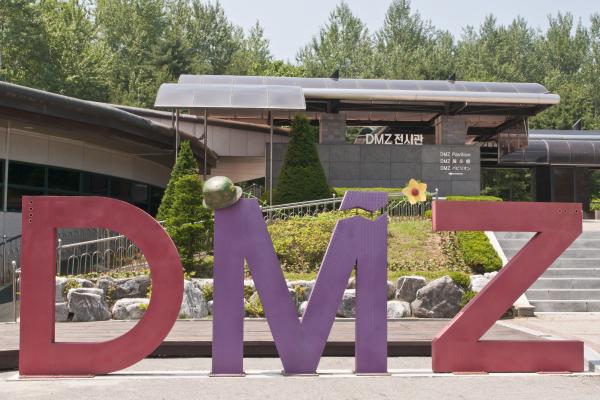Recently, I had the opportunity to visit the DMZ (Demilitarized Zone) between the two Koreas along with a group of students and faculty from George Fox University. As the most fortified border on the entire planet, the DMZ contains an arsenal of tanks, land mines, watchtowers, razor wires, artillery, and nearly two million armed troops ready to face off within a moment’s notice. Former President Bill Clinton described the DMZ as the “scariest place on earth,” a description more eerie coming from one of the few people in history to have had direct access to the “button.”
While observing the various sites within the DMZ, I thought about how the pacifist Quakers, who founded my school in 1885, would have reacted to such an experience. As a biblical studies professor, I routinely have the opportunity to explore the complexity of the theological views of pacifism with my students.
Many passages of the Hebrew Bible/Old Testament present a God, who initiates war. Before entering the Promised Land, God commands his people, “You must not let anything that breathes remain alive. You shall annihilate them — the Hittites and the Amorites, the Canaanites and the Perizzites, the Hivites and the Jebusites — just as the LORD your God commanded” (Deuteronomy 20:16b-18, NRSV).
Of course, such divinely sanctioned violence does not stop with the conquest of Canaan, but continues throughout the entire settlement period, the time of the Judges, the monarchy, the exile, and the post-exilic period. The most instinctive pacifist reaction to such texts is to turn to the saying of Jesus, and to insist that the ethics of the Gospels compel a charge to nonviolence. But even Jesus responded in violence when clearing the temple (Mark 11:15, NRSV), and warns, “I have not come to bring peace, but a sword” (Matthew 10:34b, NRSV). Although all of these examples come in complex historical contexts that do not necessarily lend itself to just war theory, these verses add tension to any claims of an unequivocal biblical ethic of peace.
The paradox of pacifism was particularly evident at the DMZ during the tour of Third Tunnel of Aggression. This infiltration tunnel is one of an unknown number of secret underground tunnels dug by the North Koreans to give them the capability of advancing troops behind the borders for any strategic launch to overtake Seoul. At the deepest point of the tunnel, we were a mere 500 feet from the demarcation line separating North and South Korea. Because this is literally the closest spot to the geographic space of North Korea for a non-authorized South Korean citizen, the Third Tunnel of Aggression has served as a place of great catharsis for many Koreans, separated from their families due to the armistice of July 27, 1953, dividing North and South Korea for six decades and counting.
As I think about Third Tunnel of Aggression, I consider my own family narratives against the backdrop of the Korean War. My mother, as a young girl, was separated from her father for a year, while he was forced into hiding in Seoul. In 1950, my father’s brother was executed as a communist sympathizer. My wife’s grandmother was chosen for a special lottery in 2000 to visit her North Korean brother, whom she had not seen since 1953. He was blind and deaf at the time of the reunion, and she has since passed.
I am grateful for the Third Tunnel of Aggression. Although conceived and built with the intent of violence, its discovery and consequent accessibility have transformed its initial purpose. As a relatively, open-access tourist site, the tunnel allows the older Koreans with longstanding pain from the Korean war to have a space where they might confront their own tragic narratives. The younger generation, who grew up knowing Korea as an advanced G20 nation, may still use the tunnel to remember the impoverished, war-torn country of our parents and grandparents. And the foreigners, like our own students, may experience a visceral walk through a tunnel created to murder and destroy, now made to commemorate and reflect.
Despite my own formal training in Semitics and biblical criticism, this walk through the Third Tunnel of Aggression gave me a completely new viewpoint on the paradoxical theology of pacifism. Both the biblical texts and the DMZ point to a God, who provides opportunities for people to reflectively consider the despair of an earlier time, in order to look forward with hope. Such a paradox also fits the life of Jesus of Nazareth as recorded in the Gospels.
It is true that Jesus violently cleared the temple during a particular moment of crisis. But such an action did not define the Prince of Peace.
Roger S. Nam, PhD, is Assistant Professor of Biblical Studies at George Fox University, and the author of Portrayals of Economic Exchange in the Book of Kings (Brill, 2012). He lives in Lake Oswego, Ore., with his wife and two children.
Got something to say about what you're reading? We value your feedback!
